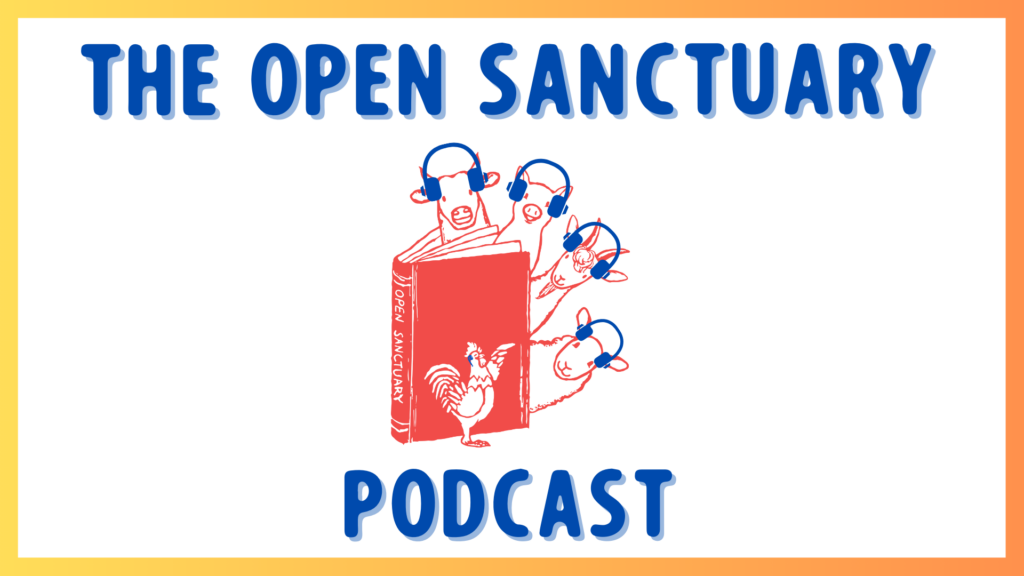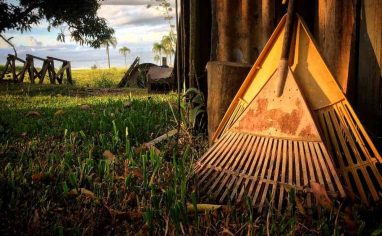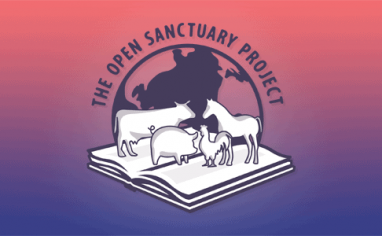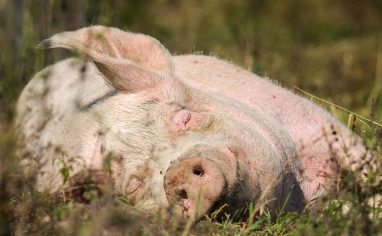
Subscribe To The Open Sanctuary Podcast
If you’d like to get the latest episodes of The Open Sanctuary Podcast, you can subscribe for free on all Podcast platforms, including Apple Podcasts and Spotify!
Episode Notes
At The Open Sanctuary Project, we believe that animal resident enrichment should be incorporated as an aspect of general care rather than seen as an “extra.” To make the sometimes daunting prospect of enrichment feel a bit simpler, more accessible, and more affordable, our Research Specialist Amber discusses some easy enrichment tips with Andie and Tara, as well as the benefits of enrichment both for residents and the humans at animal organizations.
—
This Episode’s Referenced Resources:
- Time To Thrive: 10 Easy And Inexpensive Enrichment Ideas
- Time To Thrive: The Importance Of Enrichment
- Time To Thrive: Safety Considerations For Enrichment
- Nutritional Enrichment At Animal Sanctuaries
- The Caregiver’s Guide To Developing Your Observation Skills
- Care Staff Retention At Your Animal Sanctuary
Episode Transcript (Auto-GeneratedThe following content was transcribed through an automated process and may contain transcription errors or misspellings.)
Amber Barnes: This is our first Open Sanctuary Project podcast, which is pretty exciting and it’s also especially exciting because it’s one of my favorite topics. I am Amber Barnes. I’m the research specialist here and I am here with Tara who’s our senior adviser and Andie who’s our community education specialist. So, you want to say hi?
Tara Hess Hello. Hello.
Amber Barnes Hey. I love enrichment and one of the big things we have been doing here at the Open Sanctuary Project is trying to change the way we view enrichment, which is often seen as an extra. Like if you have everything else done, then this could maybe be something you toss in. But we’re really trying to get it seen as part of general care. It’s so important. There are so many different types of enrichment and they make such an impact, generally positive, on resident well-being. And there are times where you think something might be enriching and that someone’s like, “What? I didn’t care for that giant bouncy ball,” and then it’s not enriching. So, I just wanted to ask Tara, starting off, what do you imagine are some of the biggest hurdles to incorporating enrichment into a care routine? My sense is the biggest hurdles and the places people get stuck is thinking about the time commitment that it might take, because caregiving is just so busy to begin with. And then also money. If you’re using things that are expensive, money can already be tight. There are so many unforeseen expenses that come up. So, finding and justifying the budget.
Tara Hess Absolutely. And yeah, Andie’s here. We can see each other. She’s shaking her head yes. So, yeah, we’re on the same page here. Like, “Oh, everyone just has a lot of extra sanctuary money just lying around for enrichment.” It’s hard to think about enrichment sometimes when you just paid like a $1,000 vet bill, and we know that sometimes that’s a cheap vet bill. So, and you’re like, “Oh, now I was supposed to find money in the budget for something else.” Well, I absolutely agree. There’s obviously a lot of other little challenges that can come up, but the two biggest ones I think really are time, which you generally don’t even have enough for what you’re already doing. Because, when you’re caring for residents, something new always pops up that you can’t plan for. And then where does that extra time go? And also the cost. We don’t have a lot of extra money lying around at sanctuaries generally speaking. So, how can we make this something that’s easier to approach? Because I think a lot of sanctuaries struggle with it. You approach that, you hit the wall of time and money, and then it’s like, “I can’t deal with all that extra challenge right now. So, I’m going to handle something that we can just look at, take care of,” and that’s completely understandable. I’ve been there. The good news is that I’m actually working on an enrichment resource that’s all about just cheap and easy. So, inexpensive enrichment that’s also easy to procure because that’s another thing is you can say, “Oh, it’s easy to make or easy to give.” But you also want something that’s nice when something’s just already there that you can use, right? Yeah. So, along those lines with the inexpensive is there’s a lot of different things that can be incorporated that might be leftover. Even something like cardboard boxes can be a good enrichment for certain resident species to try and dig into. You can paw at it. You can stick your snout in it. There are a lot of different things you can do. You can turn a cardboard box into a rooting box, a foraging box. We’ve all been there, right? We’ve either been the kidA young goat or maybe a cat where you get an expensive cat tree or something and they’re like, “This box is just primo.” So, things in the summer, popsicles. If you have leftover plastic containers, you just put water in there, you chop some veggies, you freeze it, you pop it out, and then cowWhile "cow" can be defined to refer exclusively to female cattle, at The Open Sanctuary Project we refer to domesticated cattle of all ages and sexes as "cows." residents have this fun popsicle to lick and try and get carrots out of. It costs whatever leftover takeout plastic container or thing like that that you have laying around and water and produce that you’re already going to hand out. So, those are just two examples.
Amber Barnes I think folks just, and myself included, just get overwhelmed by the idea of it, but then having these clear, easy ideas that you can actually incorporate as opposed to this massive topic of enrichment, like, “How do I even have time to figure that out?”
Andie Springirth Yeah, I would also say, just on the topic of making it super easy, is calling on your local community for help with this. There are a lot of different organizations, even grocery stores and different groups that might be nearby that are willing to partner up with your sanctuary and donate leftover produce that could be perfectly good still, which often times it is. And of course, making sure that prior to giving them any nutritional enrichment in this way to your residents, making sure that they’re pre-approved by all the caregiving staff, non-toxic, not moldy, rotten, etc. But I think that, yeah, partnering with your community members can be a great way to make this more manageable, too. You don’t have to think so much about how you have to go out and get it. A lot of folks are usually very willing and happy to collaborate with different animal sanctuaries in this way.
Amber Barnes Yeah. No, absolutely. I love that you jumped in with that. Another community involvement along with this is different seasons you can put out a community call. Like right now it’s summer. There was a sanctuary not far from where I’m at, and we’re spread out all over the country, that was having a watermelon fest and basically they had a little fundraiser, and if you brought a watermelon then you got like $5 off or something of their ticket for their fundraiser. They got dozens of watermelons that the community just brought in, and all they did was set up a Facebook event. Just one more thing that you could do with the community.
Tara Hess I just want to add too, Amber, that once you involve your community as well, it’s enriching for the residents at the sanctuary, right? The non-human ones, the caregivers, and also the other human community members that are surrounding your sanctuary. And what a great way to build community in your local area and also to raise more awareness that way, right? We can bring more people in when we collaborate in that way. I think sometimes sanctuaries get contacted, or at least this was my experience again, because you’re already sort of busy and maybe overwhelmed and just over capacity, not sorry, not in terms of animals but in terms of what one person can do. And then someone reaches out and says, “I’d like to help. How can I help?” And sometimes that in and of itself is like, “I can’t handle one. I can’t train you.” You get overwhelmed by all the things that would take more time and energy to try to train somebody to do. But that’s such a welcoming, fun, doable way to get folks involved where they might even be able to see the payoff of what they’re doing if it works out for the sanctuary, can see your box in action on Facebook or something.
Andie Springirth Yeah, you could even create a collection point, right, and put flyers up in your community or ask different local organizations to put that up. And maybe the collection point is at the entrance of your sanctuary or at another prespecified place that’s safe for folks to drop off things. That might also open up some more avenues in terms of accessibility if you’re kind of in a remote area, but there’s a local town maybe 15 minutes down the road where it’s easier for folks who don’t have as much capability of driving out. So that can create another opportunity for more folks to participate there as well. I was just also thinking in terms of making this easier in terms of time and also money. And it reminded me of the possibility for sanctuaries to grow their own nutritional enrichment, right? Types of foods and produce. And I know that that takes time, but in my own experience, there are a lot of different types of produce that just kind of come back. We just had three pumpkin plants just grow back on their own from last fall. That’s another nice way to cut costs potentially if you have your own small little space to grow produce. And then you also know what you’re getting, right? You know exactly where the produce is coming from for your residents. So.
Amber Barnes That’s a really great point. And as you said once again, it’s also enriching in so many different ways for so many different people, non-human and human, which those are my favorite is when everyone’s really getting something from it. Tara made this really important point. People want to help, but sometimes it’s so hard to figure out how to help you help, right? There has to be some ways. Andie mentioned just posting something, posting calls for things. So if you have volunteers, you could have enrichment volunteers even that go into the community. Yeah. Or they have days where they make different enrichment things for the residents. And then even if it’s not something where the community can be involved in with physicality speaking. You could do videos. You can post those videos to your social media accounts which so it’s all tying into different areas. People share that and then you get more awareness about these wonderful non-human people and also maybe more funders, more volunteers potentially, more people that are aware of you that can even you might want to work there. There’s just there are so many things about that. All of that just comes from enrichment, just an easy enrichment, right? Enrichment, you’re having someone else essentially take care of. That seems like a good deal.
Tara Hess Yeah. One other thing that came to mind, which is maybe a big time topic that needs to be addressed on its own. But I think when I used to think about time in terms of enrichment, I didn’t know a lot about enrichment. It was just sort of this vague idea where I was going to have to do one more thing, but I wasn’t really seeing the full picture. I wasn’t factoring in the ways in which the right enrichment program might affect the residents in a way so that certain things don’t take as much time as they used to. I think of some of the social dynamic things that can come up with certain species with introductions or even changes of season or things that can be really challenging and time-consuming to navigate while keeping everyone safe and the ways in which enrichment might not totally make everything super easy but can make things go more smoothly if done in the right way. So you might save time somewhere else once you get those.
Amber Barnes That’s a great point and it’s particularly when you talked about social dynamics. There are a number of studies for a number of species that focus on different types of enrichment and how it reduces incidences that are confrontationalBehaviors such as chasing, cornering, biting, kicking, problematic mounting, or otherwise engaging in consistent behavior that may cause mental or physical discomfort or injury to another individual, or using these behaviors to block an individual's access to resources such as food, water, shade, shelter, or other residents.. Everyone knows if you’re in there trying to separate and get someone to be here and someone else to be over here and there’s a confrontation happening, how much time that can take. You’re trying to make sure everyone’s safe. Which is top priority that can take a lot of time. But enrichment, if you find the right things that are reducing that type of conflict, then that right there can save time and also it’s just better for everyone’s overall well-being. So that’s an excellent point you make and I think it would make sense for us to actually look at a resource and kind of look at ways where it’s possible that yes, it does take time, but here are other ways where it can either save time or come out as a wash a little bit while also having other benefits.
Tara Hess Yeah. Yeah, that makes sense because I think it’s the combination of the ways it might save time. And sometimes it’s not even the actual time that elapses. It’s the emotional and physical energy that goes in that really can make that 10 minutes feel like it added two hours to your day. So.
Andie Springirth Oh, goodness. Don’t I know that. Yeah. Yeah, sorry that a little tangent, but.
Amber Barnes No, that was actually a really great tangent. So, I’m glad that you mentioned that because that, I would say, is another aspect that it ties into the time thing, time and money. And so how can we look at this differently? How can we remind ourselves of some of the other benefits that actually kind of even things out with time? That’s great. I love that. So, now we also have a new resource to work on.
Tara Hess Yeah, pause and see.
Amber Barnes Yes, that’s right.
Andie Springirth No, it actually this made me think of a couple more podcast episodes, just in terms of Amber, I know you already have some wonderful resources on creating programs and schedules and routines around this stuff. I think it could be really beneficial. But also safety, right, that we’re talking about for residents, for caregiving staff, and also for folks who you may be incorporating into your enrichment routine, visitors, children, adults, etc. That’s another topic that we could certainly talk about in a whole other episode.
Amber Barnes Yeah, absolutely. I like that.
Tara Hess Amber, I can’t remember if this is a resource that you have or if it’s just something that’s mentioned in another resource and I know you mentioned it already here, but I feel it’s such an important thing to stress is the way that it can be enriching for caregivers because sometimes depending on, I’m sure you both have had this too, where your day depending on what shift you’re on or what’s going on, you’re doing these things that are important and needed but the animals, maybe the residents, don’t love the things that are on your to-do list today. Like Andie doesn’t want the shot and to have his foot wrapped again and he sort of hates you right now and it’s heartbreaking and it’s stressful. And it needs to be done. But to add something else to the mix that, especially if you’re on a team where there’s a bunch of people that you can sort of rotate through or everyone has a little chunk of time every so often to focus on, where you’re really just doing something that is also necessary but feels good and feels restorative for you. Cause sometimes the further, this is what I found in my caregiving when I was working and getting paid as a caregiverSomeone who provides daily care, specifically for animal residents at an animal sanctuary, shelter, or rescue.. And I’m not sure if you two did, but it’s the more I learned and the more I sort of moved up, the less fun my day was in terms of some of the things that I had to do and the interactions I was having with residents were different. And the amount of time I had to just sort of sit and be with them was replaced by other things. And so to be able to have this carved out time that it’s, “No, this is important. You actually do just need to do this creative thing that will make you happy or sit here and watch how the chicken residents respond”.
Andie Springirth I feel it is just it’s so important.
Tara Hess Yeah. So, build this into your caregiving staff routine. This is not, as Amber mentioned right from the get-go, beginning of this episode, it doesn’t and probably shouldn’t be something that’s just an extra. If you can build it into your caregiving routine, I think it’s beneficial for everybody, isn’t it?
Amber Barnes Absolutely. Absolutely. It really can be restorative in that way. And I think if we just, as we’re talking about, it’s kind of flipping that in our minds, our perspective on this. It’s not something that’s extra. It’s something that’s important. It’s also something that Tara was mentioning that allows you time to observe your residents in a different kind of scenario. And also, it can be really healing. It could be healing to see them immediately enjoying something, experiencing joy. We should all be able to see our residents experiencing joy. So, I feel like we could talk forever about enrichment and everything else, but I know we’re trying to keep these kind of within reason. So, also I just have to say really quick that I love that your example was Andie because I was like, “We’re not talking about Andie or the keys.” Yeah, I am I.
Andie Springirth And you wrap her hugs. Very great about it. I may have been drawing on personal experience there, though. I am not super fond of shots, so you weren’t too far off.
Amber Barnes Yeah, there we go. Okay. Well, thank you both for talking with me and I just love working with all of you and you’re both amazing and bring so much to this conversation and just to the resources in general. And I hope all of you out there have found this helpful. And you can find us at opensanctuary.org and search enrichment. A whole bunch of resources are going to pop up for you. Is there anything the two of you would like to add as we kind of sign off for the first time? I was just going to say that we’re going to link the resources that we mentioned and also the other ones that we think would be beneficial based on this episode’s topic in the show notes. So, please do check those out.

Got A Podcast Idea? Contact Us!
If you have a topic or question you’d love to hear our staff address on The Open Sanctuary Podcast, please get in touch via our contact form!








